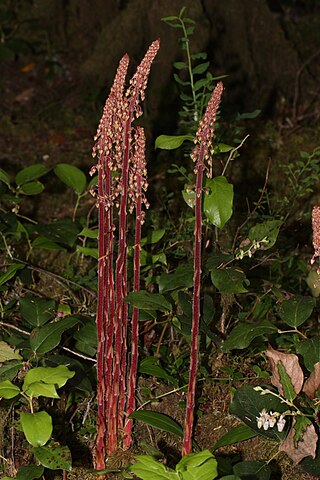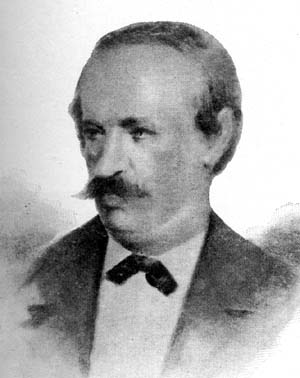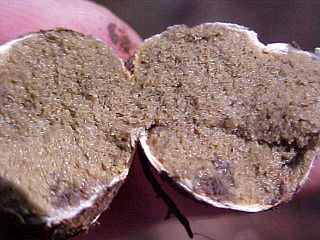
A truffle is the fruiting body of a subterranean ascomycete fungus, predominantly one of the many species of the genus Tuber. In addition to Tuber, over one hundred other genera of fungi are classified as truffles including Geopora, Peziza, Choiromyces, and Leucangium. These genera belong to the class Pezizomycetes and the Pezizales order. Several truffle-like basidiomycetes are excluded from Pezizales, including Rhizopogon and Glomus. Truffles are ectomycorrhizal fungi, so they are usually found in close association with tree roots. Spore dispersal is accomplished through fungivores, animals that eat fungi. These fungi have significant ecological roles in nutrient cycling and drought tolerance.

The Boletales are an order of Agaricomycetes containing over 1300 species with a diverse array of fruiting body types. The boletes are the best known members of this group, and until recently, the Boletales were thought to only contain boletes. The Boletales are now known to contain distinct groups of agarics, puffballs, and other fruiting-body types.

Pterospora, commonly known as pinedrops, woodland pinedrops, Albany beechdrops, or giant bird's nest is a North American genus in the subfamily Monotropoideae of the heath family, and includes only the species Pterospora andromedea. It grows as a mycoheterotroph in coniferous or mixed forests. It is widespread across much of Canada as well as the western and northeastern United States to northern Mexico. Along with Monotropa it is one of the more frequently encountered genera of the Monotropoideae.

Rhizopogon roseolus, shōro, is an ectomycorrhizal fungus, considered a delicacy in east Asia and Japan and used as a soil inoculant in agriculture and horticulture.

Rhizopogon is a genus of ectomycorrhizal basidiomycetes in the family Rhizopogonaceae. Species form hypogeous sporocarps commonly referred to as "false truffles". The general morphological characters of Rhizopogon sporocarps are a simplex or duplex peridium surrounding a loculate gleba that lacks a columnella. Basidiospores are produced upon basidia that are borne within the fungal hymenium that coats the interior surface of gleba locules. The peridium is often adorned with thick mycelial cords, also known as rhizomorphs, that attach the sporocarp to the surrounding substrate. The scientific name Rhizopogon is Greek for 'root' (Rhiz-) 'beard' (-pogon) and this name was given in reference to the rhizomorphs found on sporocarps of many species.

Carlo Vittadini was an Italian doctor and mycologist.

Alexander Hanchett Smith was an American mycologist known for his extensive contributions to the taxonomy and phylogeny of the higher fungi, especially the agarics.

Hypomyces chrysospermus, the bolete eater, is a parasitic ascomycete fungus that grows on bolete mushrooms, turning the afflicted host a whitish, golden yellow, or tan color. It is found in Eurasia and North America, as well as southwest Western Australia.
Gertrude Simmons Burlingham was an early 20th-century mycologist best known for her work on American Russula and Lactarius and pioneering the use of microscopic spore features and iodine staining for species identification.

Suillus pungens, commonly known as the pungent slippery jack or the pungent suillus, is a species of fungus in the genus Suillus. The fruit bodies of the fungus have slimy convex caps up to 14 cm (5.5 in) wide. The mushroom is characterized by the very distinct color changes that occur in the cap throughout development. Typically, the young cap is whitish, later becoming grayish-olive to reddish-brown or a mottled combination of these colors. The mushroom has a dotted stem (stipe) up to 7 cm (2.8 in) long, and 2 cm (0.8 in) thick. On the underside on the cap is the spore-bearing tissue consisting of minute vertically arranged tubes that appear as a surface of angular, yellowish pores. The presence of milky droplets on the pore surface of young individuals, especially in humid environments, is a characteristic feature of this species. S. pungens can usually be distinguished from other similar Suillus species by differences in distribution, odor and taste. The mushroom is considered edible, but not highly regarded.

Rhizopogon vinicolor is a species complex of ectomycorrhizal fungus which forms a mutualistic relationship with the Douglas-fir. The species was first described scientifically by American mycologist Alexander H. Smith in 1966.
Sanford Myron Zeller was an American mycologist.

Rhizopogon truncatus is an ectomycorrhizal fungus in the family Rhizopogonaceae. It was described by American mycologist David Hunt Linder in 1924.

Rhizopogon occidentalis is an ectomycorrhizal fungus in the family Rhizopogonaceae of the Basidiomycota. It occurs most commonly in western North America in association with two-needle and three-needle pine hosts. They are false truffles with fruiting bodies that are yellow on the surface and pale yellow inside. Their edibility is disputed.

Rhizopogon evadens is a truffle-like fungus in the family Rhizopogonaceae. Found in North America, it was described as new to science by American mycologist Alexander H. Smith in 1966. The fungus produces roundish to irregularly shaped fruitbodies measuring 2–5 cm (0.8–2.0 in) in diameter, with irregular lobes, wrinkles and depressions on the surface. The peridium is whitish with light yellow to brown stains, and bruises red. The fungus has an unpleasant odor and a taste described as "metallic". Typical tree associates include pine, Douglas fir, and hemlock. Initially white, the gleba turn olive to olive-brown in maturity, with the contents developing a gelatinous consistency. The smooth spores of R. evadens are narrowly ellipsoid in shape, and measure 6–8 by 2–2.3 µm.

Rhizopogon luteolus is an ectomycorrhizal fungus used as a soil inoculant in agriculture and horticulture. It was deliberately introduced into Pinus radiata plantations in Western Australia after it was observed to improve tree growth.
Rhizopogon alexsmithii is an ectomycorrhizal fungus in the order Boletales. Named in honor of American mycologist Alexander H. Smith, it was described as new to science in 1975 by James Trappe. Alfredo Vizzini and Mirca Zotti transferred it to the genus Rhizopogon in 2010.
Dow Vauter Baxter was an American mycologist. He was an authority on wood-decay fungi, especially the polypores. Baxter was a professor of forest pathology at the University of Michigan, where he started employment in 1926. The fungus Rhizopogon baxteri was named in Baxter's honor.
Rhizopogon amylopogon is a sub-genus of Rhizopogon containing seven species.

Rhizopogon salebrosus is a mushroom species within the Rhizopogon sub-genus Amylopogon. R.salebrosus is a monotropoid mycorrhiza that is of vital importance to the ecology of conifer forests, especially in the Pacific Northwest region of North America. Although it is native to North America, R. salebrosus has been found in Europe and its range is generally limited to mountainous regions with sufficient precipitation. The mycoheterotrophic plant, Pterospora andromedea is often found in an obligate association with R. salebrosus in western parts of the U.S. Eastern populations of P. andromedea are typically symbiotic with another Rhizopogon sub species, R. kretzerae.















